U.S.S. Enterprise Security Section
Created by Commodore Wilkan Targaryen on Tue Aug 20th, 2024 @ 12:56am
Security
Armory
 The Armory was a secured location aboard the Starship Enterprise where weapons and other offensive or defensive devices could be stored to prevent unauthorized personnel from gaining access. Due to the nature of the Enterprise's mission, multiple Armories were located aboard the vessel.
The Armory was a secured location aboard the Starship Enterprise where weapons and other offensive or defensive devices could be stored to prevent unauthorized personnel from gaining access. Due to the nature of the Enterprise's mission, multiple Armories were located aboard the vessel.Each Armory aboard the Enterprise shares the same basic layout and is divided into two sections. The outer compartment of the Armory is a Security Checkpoint that is monitored by a Security Specialist. Featuring dedicated workstations, the checkpoint is used to conduct inventory procedures and ensure that weapons are not provided to unauthorized personnel. Standard equipment - such as Communicators or Tricorders - were stored in the Checkpoint. From the checkpoint, personnel can then enter the Weapon's Room. This area provided personnel with access to Phasers and Phaser Rifles of varying configurations as well as explosive charges. Access to the Weapons Room was highly restricted and required voiceprint authorization for entry.
Brig
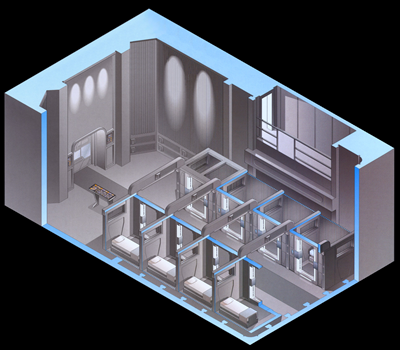 A Brig was a prison on a starship. Used to contain criminals, fugitives, those who are deemed a danger to themselves or others, or as a punishment for Starfleet personnel, the Brig is heavily guarded and keeps the incarcerated segregated from the rest of the ship.
Due to the nature of the Enterprise's missions, the Brig aboard the vessel has additional safeguards uncommon on other exploratory craft and began life as a Cargo Bay. Armed guards are posted at the entrance to the Brig at all times and a second guard is posted to an observation catwalk that overlooks the Brig cells. A single computer console is located parallel to the main entrance and includes the controls for the advanced security sensors that monitor each prisoner for potential threat to the ship and crew. A long walkway runs between the two rows of cells that is used to deliver food, observer, or transfer the prisoners.
A Brig was a prison on a starship. Used to contain criminals, fugitives, those who are deemed a danger to themselves or others, or as a punishment for Starfleet personnel, the Brig is heavily guarded and keeps the incarcerated segregated from the rest of the ship.
Due to the nature of the Enterprise's missions, the Brig aboard the vessel has additional safeguards uncommon on other exploratory craft and began life as a Cargo Bay. Armed guards are posted at the entrance to the Brig at all times and a second guard is posted to an observation catwalk that overlooks the Brig cells. A single computer console is located parallel to the main entrance and includes the controls for the advanced security sensors that monitor each prisoner for potential threat to the ship and crew. A long walkway runs between the two rows of cells that is used to deliver food, observer, or transfer the prisoners.The Brig cells aboard the Enterprise are functionally designed but are basic rooms that lack any luxuries. A single bunk has been placed against the bulkhead of the cell and serves as the only concession for comfort inside the Brig. Each cell has been built to withstand any attempts to escape and incorporate rodinium, one of the hardest known materials, in their construction. Forcefield generators built into the structure secure the prisoner in each cell and are controlled by a small keypad built into the bulkhead.
Bullpen
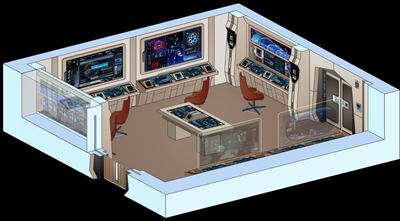 The primary control room for the Security Department, the Bullpen oversees all law enforcement operations aboard the Starship Enterprise. Featuring two independent centers, one focused on the Saucer Module and the other in the Stardrive Section, the Bullpen provides a place where Security Specialists could work.
The primary control room for the Security Department, the Bullpen oversees all law enforcement operations aboard the Starship Enterprise. Featuring two independent centers, one focused on the Saucer Module and the other in the Stardrive Section, the Bullpen provides a place where Security Specialists could work.The primary workstation within the Bullpen is the Master Situation Table. Featuring a number of computer systems embedded within, the Master Situation Table provided personnel with detailed information regarding the current mission of the starship. Computer terminals built into the bulkheads allow work areas for Security personnel to coordinate and investigate assignments. The last workstation within the Bullpen is the Master Security Monitor. Similar in design to the Master Systems Display from Main Engineering, the Master Secuity Monitor monitors reports of potential threats to the safety of personnel from throughout the Starship Enterprise and deploys teams to investigate.
Interrogation/Isolation Room
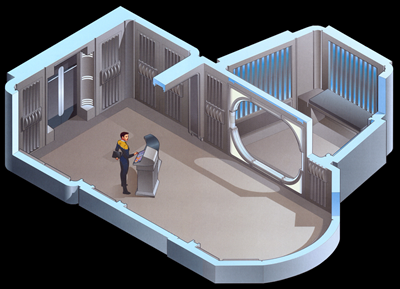 The Interrogation/Isolation Rooms aboard the Starship Enterprise are secure rooms used to hold criminals or dangerous individuals for questioning. Interrogation/Isolation Rooms are used with the goal of eliciting useful information, particularly information related to suspected crime, and commonly are conducted under an adversarial system in which personnel seek to obtain material that will aid in convicting a suspect rather than discovering the facts of the case.
The Interrogation/Isolation Rooms aboard the Starship Enterprise are secure rooms used to hold criminals or dangerous individuals for questioning. Interrogation/Isolation Rooms are used with the goal of eliciting useful information, particularly information related to suspected crime, and commonly are conducted under an adversarial system in which personnel seek to obtain material that will aid in convicting a suspect rather than discovering the facts of the case.Located deep within the Security levels, access to the Interrogation/Isolation Rooms is provided through a pair of sliding double doors. Access to the Interrogation/Isolation Room is highly restricted and no one is permitted in the room without authorization and agrees to strict supervision by a trained Security Specialist. The duty desk provides a work area for the specialist, providing access to the various security sensors located within the room that monitor the criminal and check for potential threats to the safety of the ship and crew. The room itself is spartanly appointed and personnel are given plenty of room to work with prisoners to safely escort them to the cells deeper within the vessel.
The Interrogation/Isolation Room's cell is a small room with very little area for the prisoner to move around in. The cell lacks any amenities or luxuries and features a single bed that is placed flush against the bulkhead. A small toilet is available should the prisoner have to relieve themself, but the area provides very little privacy to do so as the entire room is visible through a transparent forcefield that secures the room. Under Starfleet protocols the Security Team must notify any prisoner of the strength level of the forcefield when asked, but each unit is designed to minimize injury to the criminal except for emergency circumstances, at which point an electronic pulse could be used to detour the subject from trying to escape.
Phaser Range
 The Phaser Range was a specialized training facility aboard the Starship Enterprise that allowed Starfleet personnel to practice with their Phasers. While primarily a location for Security Officer training, the Phaser Range could also be used for relaxation.
The Phaser Range was a specialized training facility aboard the Starship Enterprise that allowed Starfleet personnel to practice with their Phasers. While primarily a location for Security Officer training, the Phaser Range could also be used for relaxation.Aboard the Enterprise the Phaser Range consisted of a circular stage set in a large empty area. The area around the stage was illuminated, but every other area of the room were commonly dark. When activated flashing spheres of light of different colors and moving at various speeds served as the targets, allowing as many as two people to practice at the range at any one time either in a cooperative or competitive manner. Depending upon the interests of the participants, personnel could chose to use drones as the targets, rather than light-based spheres.
Often the Phaser Range was used to play Velocity, a one-on-one competitive sport that was a cross between handball and a shooting competition. A fast-paced game of wit and physical endurance, each player was assigned to a color (either red or blue) and had to avoid being hit by a disk by shooting it and sending it toward their opponent. The holographic disk used in the game would glow a different color when hit by a competitor's Phaser, taking on the color of the contestant. The game was played in rounds and was only concluded when a player was impacted by the disk.
Tactical
Deflector Control Room
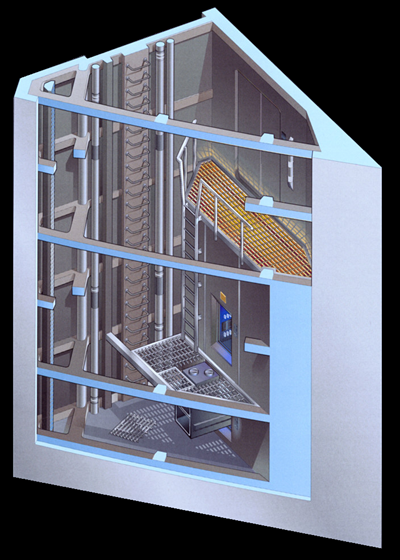 The Deflector Control Room, or known more simply as Deflector Control, aboard the Enterprise was responsible for repairs and modifications to the ship's deflector relays and similar systems. Each Deflector Control Room aboard the Enterprise was positioned directly behind the vessel's Deflector Dishes and ran the length of the assembly.
The Deflector Control Room, or known more simply as Deflector Control, aboard the Enterprise was responsible for repairs and modifications to the ship's deflector relays and similar systems. Each Deflector Control Room aboard the Enterprise was positioned directly behind the vessel's Deflector Dishes and ran the length of the assembly.Deflector Control aboard the Enterprise was accessed by a pair of doors that led onto a small, metal balcony that overlooked the facility and its contents. A series of ladders built into the compartment allow personnel to climb down to the control interfaces and circuitry located on the lower catwalks to make any necessary changes. As the Deflector circuitry is highly sophisticated and critical to the safety of the Enterprise, Starfleet Security has included multiple safeguards to ensure access is restricted to only authorized personnel only.
To access the Deflector Relays, a technician travels to the lower catwalk and removes a sectional hatchway to gain entry. Consisting of a series of computer chips and control consoles, the Deflector Relays can be extracted from the wall assembly to streamline maintenance needs. To enhance the speed of repairs, Engineers can elevate the relays to the upper level to allow additional personnel the opportunity to work on the same project. When complete the equipment can be returned to its original location with ease.
Phaser Control Room
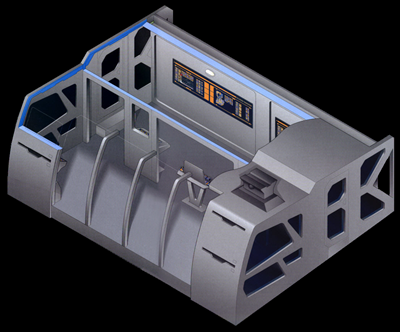 The Phaser Control Room aboard the Enterprise was responsible for the coordination and maintenance of the ship's Phasers. While the actual firing command was triggered from the Tactical station, Phaser Control was capable of firing Phasers without Bridge direction.
The Phaser Control Room aboard the Enterprise was responsible for the coordination and maintenance of the ship's Phasers. While the actual firing command was triggered from the Tactical station, Phaser Control was capable of firing Phasers without Bridge direction.The Phaser Control Rooms were compact, efficiently designed work areas that were manned by Security Specialists trained in space combat. Designed to maximize collaboration among the teams, the Phaser Control Room featured two secured entryways located on the side walls of the room. The rear wall of the room featured a large computer console that ran the length of the bulkhead while the front wall incorporated large windows. Freestanding consoles were placed in the center of the room that controlled the firing systems. Holographic emitters built into the surrounding window were designed to project details over the window, including information from the sensors or targeting protocols. Armored bulkheads surround this window and include small window 'peep holes' that can be used by the personnel manning the workstations built into these walls. The Phaser Control Rooms are dark with the illumination often coming from the computer terminals and nominal overhead lighting.
Tactical Information Center
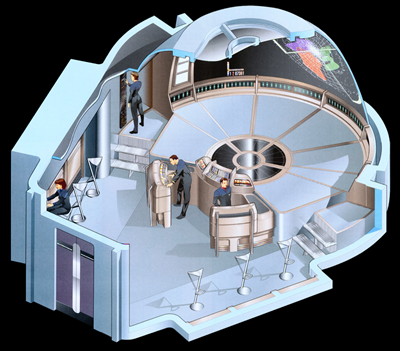 The Tactical Information Center aboard the U.S.S. Enterprise functions as a tactical center and processes information into a form more convenient and usable by the Captain or another Mission Commander. Some control, assistance, and coordination functions may be delegated to the staff by the Bridge, such as overseeing the mode and prioritization of sensor resources or communications to external sources and assets.
The Tactical Information Center aboard the U.S.S. Enterprise functions as a tactical center and processes information into a form more convenient and usable by the Captain or another Mission Commander. Some control, assistance, and coordination functions may be delegated to the staff by the Bridge, such as overseeing the mode and prioritization of sensor resources or communications to external sources and assets.Enterprise's Tactical Information Center was a restricted area that was overseen by a member of the ship's Security Department; however, when Enterprise hosted a Flag Officer they would typically work from this location. Featuring a single door, personnel entering the tactical Information Center would immediately see the colossal, wraparound, holographic wall screen that dominated the area. Designed to display a stellar region three-dimensionally, the holotank would often be used to prepare for fleet deployments or to analyze threat force actions. For convenience or advanced analysis, the Tactical Information Center could also be used for communications purposes or even as a workplace for easy access to sensor information. Located in the center of the room, a series of control panels provided up to the minute details and priority linkages to the command-and-control functions of the Enterprise. Open space between these consoles and the holotank could be used as a stage for presentations and additional, configurable workstations were located on the port and starboard bulkheads. If needed, command functions could be transferred to the Tactical Information Center with the approval of the ship's Captain.
Torpedo Bay
 The Torpedo Bay was the area on the Starship Enterprise in which the vessel's torpedo complement were stored, and the torpedo launcher could be accessed. The Torpedo Bays aboard the Enterprise were highly automated locations; however, launchers could still be modified for manual launch. In a manual launch the person performing the launch had to be located inside the torpedo tube, causing plasma exhaust to burn the crewmember.
The Torpedo Bay was the area on the Starship Enterprise in which the vessel's torpedo complement were stored, and the torpedo launcher could be accessed. The Torpedo Bays aboard the Enterprise were highly automated locations; however, launchers could still be modified for manual launch. In a manual launch the person performing the launch had to be located inside the torpedo tube, causing plasma exhaust to burn the crewmember. Heavily reinforced by the Enterprise's armor for additional protection, each Torpedo Bay aboard the Enterprise shares the same general layout. Long and narrow rooms, torpedoes are lowered from the upper-level magazine into the launching mechanism. Once loaded, personnel can make last minute adjustments to the torpedoes or begin the launch process. When the torpedo is ready to be deployed, it begins to be transferred down the launch track. Located in a slightly recessed area of the deck plating, the launch track leads directly to the torpedo launch tube.
Slightly larger than the torpedo itself, the Torpedo Tube separated the Torpedo Bay from the outer hull of the Enterprise. Protected by an inner door that would protect the bay from the Torpedo's propulsion systems, when torpedoes were fired, the outer doors would open to allow the torpedo to launch toward a target.
Disclaimer
Categories: No categories found